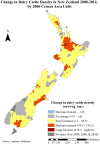Dairy Cattle Density and Temporal Patterns of Human Campylobacteriosis and Cryptosporidiosis in New Zealand
- PMID: 35689151
- PMCID: PMC9276729
- DOI: 10.1007/s10393-022-01593-9
Dairy Cattle Density and Temporal Patterns of Human Campylobacteriosis and Cryptosporidiosis in New Zealand
Abstract
Public health risks associated with the intensification of dairy farming are an emerging concern. Dairy cattle are a reservoir for a number of pathogens that can cause human illness. This study examined the spatial distribution of dairy cattle density and explored temporal patterns of human campylobacteriosis and cryptosporidiosis notifications in New Zealand from 1997 to 2015. Maps of dairy cattle density were produced, and temporal patterns of disease rates were assessed for urban versus rural areas and for areas with different dairy cattle densities using descriptive temporal analyses. Campylobacteriosis and cryptosporidiosis rates displayed strong seasonal patterns, with highest rates in spring in rural areas and, for campylobacteriosis, summer in urban areas. Increases in rural cases often preceded increases in urban cases. Furthermore, disease rates in areas with higher dairy cattle densities tended to peak before areas with low densities or no dairy cattle. Infected dairy calves may be a direct or indirect source of campylobacteriosis or cryptosporidiosis infection in humans through environmental or occupational exposure routes, including contact with animals or feces, recreational contact with contaminated waterways, and consumption of untreated drinking water. These results have public health implications for populations living, working, or recreating in proximity to dairy farms.
Keywords: dairy cattle density; public health; zoonoses.
© 2022. The Author(s).
Conflict of interest statement
The authors declare no conflicts of interest.
Figures










Similar articles
-
Cryptosporidiosis Risk in New Zealand Children Under 5 Years Old is Greatest in Areas with High Dairy Cattle Densities.Ecohealth. 2016 Dec;13(4):652-660. doi: 10.1007/s10393-016-1187-8. Epub 2016 Oct 20. Ecohealth. 2016. PMID: 27766441
-
The occurrence of Cryptosporidium parvum, Campylobacter and Salmonella in newborn dairy calves in the Manawatu region of New Zealand.N Z Vet J. 2005 Oct;53(5):315-20. doi: 10.1080/00480169.2005.36566. N Z Vet J. 2005. PMID: 16220123
-
The transmission of thermotolerant Campylobacter spp. to people living or working on dairy farms in New Zealand.Zoonoses Public Health. 2008 Sep;55(7):352-60. doi: 10.1111/j.1863-2378.2008.01142.x. Zoonoses Public Health. 2008. PMID: 18667028
-
Emergence of zoonotic Cryptosporidium parvum in China.Trends Parasitol. 2022 Apr;38(4):335-343. doi: 10.1016/j.pt.2021.12.002. Epub 2021 Dec 28. Trends Parasitol. 2022. PMID: 34972653 Review.
-
A cluster of three cases of leptospirosis in dairy farm workers in New Zealand.N Z Med J. 2014 Jan 24;127(1388):13-20. N Z Med J. 2014. PMID: 24481382 Review.
Cited by
-
Campylobacter jejuni Response When Inoculated in Bovine In Vitro Fecal Microbial Consortia Incubations in the Presence of Metabolic Inhibitors.Pathogens. 2023 Nov 26;12(12):1391. doi: 10.3390/pathogens12121391. Pathogens. 2023. PMID: 38133276 Free PMC article.
-
A review and analysis of cryptosporidiosis outbreaks in New Zealand.Parasitology. 2023 Jun;150(7):606-611. doi: 10.1017/S0031182023000288. Epub 2023 Mar 20. Parasitology. 2023. PMID: 36938817 Free PMC article. Review.
-
Tackling Soil ARG-Carrying Pathogens with Global-Scale Metagenomics.Adv Sci (Weinh). 2023 Sep;10(26):e2301980. doi: 10.1002/advs.202301980. Epub 2023 Jul 9. Adv Sci (Weinh). 2023. PMID: 37424042 Free PMC article.
References
-
- Abdelmajid D, Gordon N, Gianni L, Lora F, Anthony K, Sari K, Iain L, Christophe S, Richard E, Christopher L, Christophe H, Trevor B. The seasonality and effects of temperature and rainfall on Campylobacter infections. International Journal of Population Data Science. 2017;1(1):1125.
-
- Al Mawly J, Grinberg A, Prattley D, Moffat J, French N. Prevalence of endemic enteropathogens of calves in New Zealand dairy farms. New Zealand Veterinary Journal. 2015;63(3):147–152. - PubMed
-
- AsureQuality. (2019). "AgriBase." Retrieved 8 January 2019 from https://www.asurequality.com/our-solutions/agribase/.
-
- Bolan NS, Laurenson S, Luo J, Sukias J. Integrated treatment of farm effluents in New Zealand’s dairy operations. Bioresource Technology. 2009;100(22):5490–5497. - PubMed
-
- Britton E, Hales S, Venugopal K, Baker MG. The impact of climate variability and change on cryptosporidiosis and giardiasis rates in New Zealand. Journal of Water and Health. 2010;8(3):561. - PubMed
Publication types
MeSH terms
LinkOut - more resources
Full Text Sources
Medical

